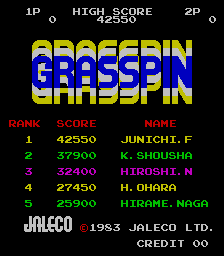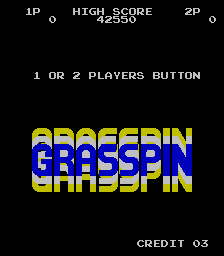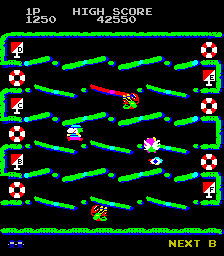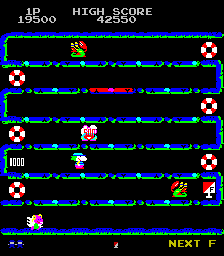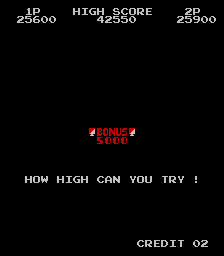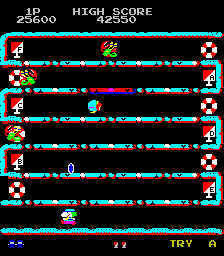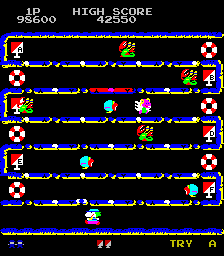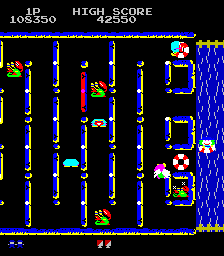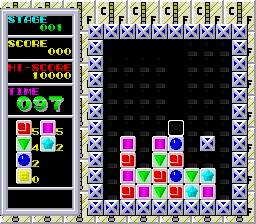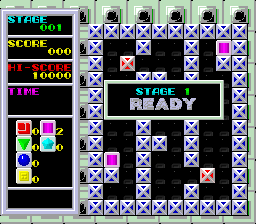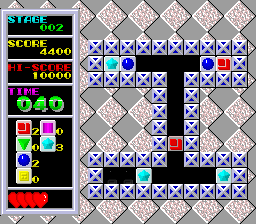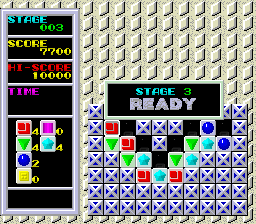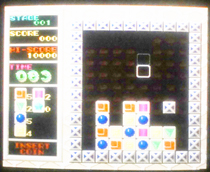I’ve been holding off doing an update on this one for a couple of days because there are still a few issues to iron out, however the visuals seem OK now even if I remain unconvinced over the implementation. Anyway, on to the update.
Italy has been a treasure chest for rare PCBs turning up for a while now and what we have here is another one. Still on a high from finding Planet Probe, the duo of Alberto Grego and ‘Zabanitu’ found what they thought was a regular Jaleco ‘Saturn’ PCB, however on booting it they found out it was something much, much more interesting. What they actually found they were in possession of was a game called ‘Grasspin’ running on the same hardware, a game which there is apparently no record of in Japan, or anywhere else for that matter, a piece of history completely forgotten until that moment in time.
Now, there are likely several reasons why there are no traces of the game in the history books. The most likely of those reasons is that it’s a prototype, an unreleased game, something which failed it’s location test and was shelved; although you still hear about many of those and we have screenshots from plenty of long-lost games falling into that category so that alone really isn’t reason enough alone for it to be completely unheard of.
The second contributing factor requires a little more digging. The games Jaleco released on the ‘Blueprint’ / ‘Saturn’ board were not developed by Jaleco. We know from credits in the roms that a company called Zilec were involved in the production of the games. Zilec were a UK company and produced a number of conversions, as well as a selection of games exclusively for Jaleco. Jaleco also oversaw the arcade game Dingo, produced by Ashby Computers. What all this has in common is that it represents the history of a company better known back then as ‘Ultimate Play the Game’ or today as ‘Rare’ If you look in the sound rom for Grasspin you’ll see credit given to “CHRISTOPHER STAMPER,JOHN LA” (which I’m guessing should be JOHN LATHBURY, as credited in Saturn, but has been truncated)
Now, assuming those credits aren’t just a leftover it would strongly indicate that that game was also developed by Zilec (and the main character sprite reminds me a lot of Blue Print) The default high score table does throw some doubt on this because the names all appear to be Jaleco staff rather than Zilec staff, but it is rather traditional for this to be the case. Anyway, if we go on the logic that the game was developed in the UK, and tested in Italy it’s possibly it never even reached the Japanese shores at all, despite Jaleco’s involvement. That doesn’t explain why nobody remembers it here, but we’ve never been as thorough with record keeping it would seem whereas the Japanese even have high score lists for games many consider to have never been released!
As mentioned at the start, there are a few peculiarities with the emulation, first off there seems to be a minor comms issue between the two CPUs (the existing hookup for Blue Print / Saturn is apparently wrong) this causes you to always have infinite lives, because it thinks that dipswitch is always on (the dipswitches are read via the AY sound chip on the sub-cpu side then passed to the main CPU) It also seems to access video ram in a rather unusual way, often writing the upper tile attribute bits to the line after they’re needed, but a dump of the video RAM from the PCB seems to show everything in the right place. For the first reason the game is still tagged as NOT WORKING, although it is playable.
The game, it’s an a decent concept, but not really too well implemented and probably shows the weakness of the hardware a little too much. The whole thing centers on the novelty of being able to ‘spin’ the grass (the lines which make up the maze) by pressing a button, so yes, while the name ‘Grasspin’ may seem like a nonsensical word at first it’s simply a pun on the core game concept. Every rotatable piece of the maze rotates at the same time, so you have to carefully plan when you flip based on your position, the enemy position and where things will be as well as which paths are open after you rotate.
That’s where the flaws start to appear, the biggest issue is that it’s not always obvious where anything is going to end up. Every rotatable piece has arrows on it showing the direction of rotation which should in theory help, but in reality if you get pushed or not doesn’t always feel obvious and the whole rotation effect is done with an absolute minimal number of frames of animation (due to hardware limits) so the visual effect isn’t very good and quite often you end up pushing yourself into an enemy or an enemy into you or ending up on completely the opposite side of a barrier than you expected after feeling you you transported through it rather than being pushed.
The frustration continues because the red grass near the top of the maze will push you further, and kill you and/or any enemies that happen to be standing in the way when you rotate it… sometimes.. and that’s the problem again it’s never really obvious if it’s safe or not. I’m sure if you played the game enough you’d get used to it, but that feels more like learning your way around the flaws of the game than playing it.
Now inevitably there will be times when you get trapped, and on some lines of the maze are little life rafts, if you grab one of these and continue walking you’ll float down a river to the bottom of the playfield as an emergency escape, be warned tho, turn around for a second and you’ll lose the life raft, at which point jumping in the water is fatal, another odd design choice. Not to mention that the bottom of the playfield isn’t always safe and you can end up with just as many enemies congregating there making the whole escapade pointless.
In all this I’ve failed to mention what you actually need to do to finish a level. It’s actually rather simple, down the sides of the level are 6 flags, marked A-F, collect them all and you move on to the next level, collect them all in order and you get a bonus. The various bugs are what make this game look prototype-like and there’s another one when entering the areas containing the flags; if you flip the maze while entering you’ll momentarily start walking straight through the outer wall until the game realizes something bad is happening and moves you back.
Most enemies abide by the movement allowed by the maze pattern, but one of the cheaper enemies is a little Cupid / Angel thing floating around, slowly moving in diagonals and homing in on you, quite often you’ll end up trapped waiting for enemies to move, and dying because this thing gets to you before you have an escape route. Later levels / harder difficulties also add some kind of ball which just spawns somewhere near you, bounces towards you and kills you if you stand around without moving for too long, very cheap.
Level progression is almost non-existent, the mazes don’t change at all, just palette swap, and enemies become greater in number and speed as you go through the levels. In that sense it’s no different to a lot of classic games, but it doesn’t feel very rewarding because the game just starts to feel very cheap after a few levels, especially when as I’ve mentioned at the start it can be quite hard to judge where you’ll end up at times.
The sound / music is pretty decent for a game of the period, although without doing a video it’s not something you can grasp from the screenshots alone, and I don’t want to do a video until the remaining issue with the dipswitches has been ironed out.
I’ve no idea what the game-over / high-score sequence is like because as mentioned earlier you currently have infinite lives.
The game was definitely never destined to be a classic, although I’d say it was memorable so it does surprise that nobody seems to remember it at all, not even in location test form, but that’s just the way things are sometimes.
